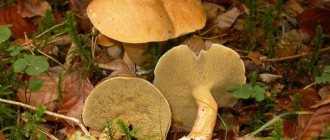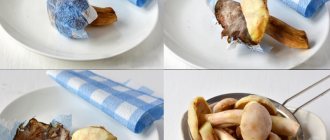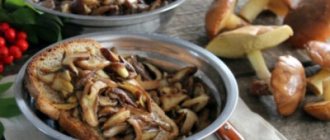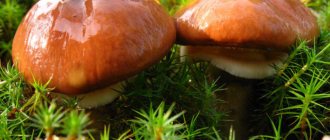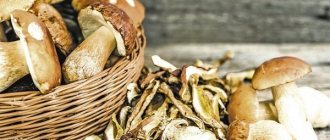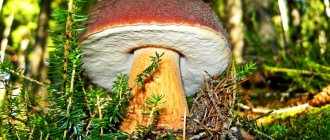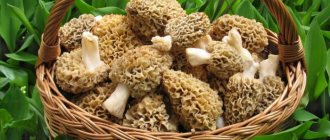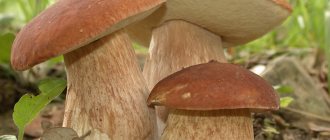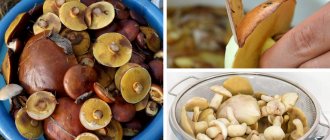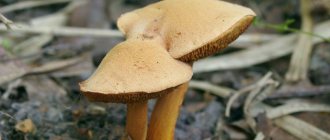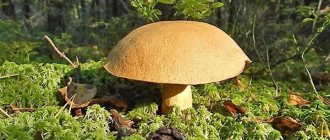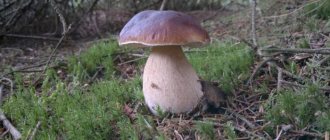Edible boletus mushrooms: what do they look like, what can they be confused with?
Butterflies have several doubles, with which they can easily be confused. At the beginning of summer, that is, in the first days of July, you can find the first wave of butterflies hiding in pine forests. At the same time, false boletus and their doubles appear, which are very similar in appearance. But there are several differences between false and true boletus. There are several types of butter. That is why the mushroom can be seen at the beginning of summer and collected at the very end of autumn.
Differences between boletus and mushroom counterparts:
- False mushrooms have a purple film and a lamellar cap on the inside. A true mushroom has a thin film on the inside of the cap, which, when removed, reveals a porous structure; there are no plates there.
- At the cut site, false boletus secretes liquid, so after a while you will see yellowing. Such a mushroom should be immediately thrown out of the basket. False butterflies are not deadly mushrooms, but eating them can cause indigestion.
- In addition, they taste bitter and can spoil the main dish. Another doppelgänger of the oiler is the panther fly agaric. The difference between these mushrooms is that the poisonous counterpart has whitish spots. That is why the mushroom got its name. Reminds me of the color of a panther.
- But when you collect boletus, leaves or blades of grass may touch the cap. After removing the debris, light spots appear. Therefore, try to collect mushrooms that have no grass or leaves on top, and whose caps are clean.
Butter
Why do boletus paint your hands?
Darkening on the fingers appears after peeling the first mushrooms.
Butter mushrooms have one not-so-pleasant property - they stain your hands a lot. It is enough to hold the mushroom for just a minute, and the skin will become covered with a dark layer that will be difficult to get rid of. But why does this happen?
Interesting: Why are boletus peeled?
Butterfly pulp contains a large amount of iron. When a cut is made on the mushroom, the substance reacts with air and oxidizes. It also transfers easily to the skin when touched.
If your hands are darkened from oil, you will have to spend a lot of effort to wipe them off. Traditional cleaning products are not very helpful in this matter. Therefore, it is better to use citric acid or nail polish remover. They remove oil stains well. After cleansing, simply rinse your hands under water.
Boletus mushrooms - edible: varieties, description, photo
Varieties of butter:
Leaf oiler. They have light gray or brownish flesh and a cap. The top is covered with a mucous coating. The leg has a characteristic ring, the flesh is porous, gray or white. Can be found in mixed forests in September and October.
Leaf oiler
The yellow-brown butterdish differs from the ordinary one in its color. The color is yellow, sometimes orange. If you break the cap, you will see the flesh of the same orange color. The stem has a characteristic ring. At the cut site it sometimes turns purple.
Yellow-brown oiler
Grainy boletus . Early species of mushrooms that can be found in coniferous forests in summer. The color is more faded than that of brown butterflies. At the same time, pores of different sizes are visible on the inside of the cap. Because of this, the oiler got its name.
Grainy boletus
Spring butter dish. It grows in young deciduous forests, as well as on sunny edges. Its surface is slightly sticky, the cap is yellow-brown in color. On the back of the cap there are pronounced pores that darken when pressed. This mushroom can be found in forests from early June to mid-September.
Spring boletus
White boletus has a light cap. In dry weather it is almost gray-white. After rain it turns olive. Mature mushrooms have a cap that is not dome-shaped, but almost flat. On mature mushrooms, gray or brown warts often appear in the cap area. When trying to remove the mucous membrane, it is easily removed.
White boletus
Types of butter
Cedar oil can
The mushroom cap is up to 10 cm in circumference. In young specimens it is hemispherical, becoming arched with age. Color from dark yellow to light or dark brown, dry or viscous. The leg is cylindrical or slightly swollen at the base. Sometimes the same shade as the cap, but more often it is paler, covered with brownish protuberances.
The pulp is yellowish or yellow and does not change color when exposed to air. The tubes are dirty mustard to red in color. The pores are small, round, mustard-colored. The smell is not distinctive. The taste is neutral. Spores 9–11.5 × 4–5 µm.
The cedar butterfly lives in coniferous forests, under trees in parks and gardens, and forms mycorrhizae with pine trees.
Oil can gray
Externally, the mushroom is inconspicuous, but the taste is pleasant to food receptors and has a characteristic mushroom smell when cooked or pickled.
The gray oil can is decorated with a cap in the form of a lumpy pillow, its diameter is 5-12 cm. The smooth film is damp and sticky on palpation, and is difficult to come off. A distinctive feature is brownish scales on its surface. When the veil is torn, it leaves flocculent particles that cover the tubular layer.
The skin is pale gray to brownish, olive or purple. The white and loose flesh under the cap film of old mushrooms becomes dirty white or brownish. Turns blue when exposed.
The bottom of the cap consists of wide tubes that run down the stem. The shape of the tubes is irregularly angular. The color is gray with a brownish, white or yellow tint.
Gray boletus reproduces by spores. They are formed in spore powder.
The tall leg of the gray butterdish is shaped like a straight or curved cylinder 1-4 cm thick, 5-10 cm long. The texture of the pulp is dense, the shade is pale yellow. The veil leaves a white rim on it, which disappears as the mushroom ages. Gray butterdish is collected in young larch or pine forests. The mushroom grows in families or alone.
Yellowish oil can (swamp)
Marsh or yellowish butterdish is one of the most delicious representatives of the mushroom kingdom. It is not one of the “noble” mushrooms, but experienced mushroom pickers know its value and brag when they find a mycelium.
The cap of the marsh butterfly is small and not thick, from 4 cm in young mushrooms, up to 8 cm in old mushrooms, and is covered with an oily film.
The developmental stages of the organism influence the shape of the cap. Hemispherical in young specimens, it flattens over time and slightly elongates closer to the stem, and a small tubercle appears at the top. The color of the cap is discreet, yellowish. In some specimens, the yellowish color is diluted with beige, grayish or pale green tones.
The rather small pores of the tubular layer of the cap are fragile, colored lemon, yellowish or ocher. The yellowish flesh of the mushroom does not emit a pronounced odor or milky juice.
A strong cylindrical leg 0.3-0.5 cm thick, 6-7 cm long, slightly curved. After the cap is detached from the stem during growth, a jelly-like translucent ring of white or dirty yellow color appears on the stem. The leg is yellowish, yellow-brown below the ring. The spore shape is elliptical, the spore powder is coffee yellow.
White oil can
The mushroom is rare, so it is better to devote mass collection to other representatives of the boletus family. Specimens quickly deteriorate after collection and sometimes there is simply no time to prepare them.
The mushroom cap is up to 8-10 cm in diameter. In young specimens, the cap is convex-spherical, the color is off-white, turning yellow at the edges. In mature mushrooms, the bulge on the cap disappears as it straightens. After overripening, the cap turns yellow and bends inward.
The smooth cap becomes covered with mucus after rain. When dry it shines. The thin skin peels off without effort. The white or yellow cap has soft, dense and juicy flesh. As they age they turn red. The tubular layer is represented by tubes 4-7 mm deep. Young mushrooms have light yellow tubes. At a later age they become yellow-green. Overripe ones are brown-olive. The color of the angular-rounded small pores and tubes does not differ. The surface of the tubular layer secretes a red liquid.
A solid leg of a curved or cylindrical shape without a ring, 5-9 cm high. When ripe, red-brown spots appear on the leg.
Late oil can (real)
This is a popular mushroom that is dried, ground into powder and used for mushroom broth. The wide convex cap is 5–15 cm, opens as it ripens and becomes flatter. Adhesive film from light brown to deep chocolate brown.
This is a mushroom that has creamy yellow pores instead of gills, they look fuzzy, and as the mushroom ages, the pores become golden yellow. Under the cap, a white veil covers the young pores; when the mushroom grows larger, the veil breaks and remains on the stem in the form of a ring. The leg is cylindrical, white, 4 to 8 cm high, 1 to 3 cm wide and quite smooth to the touch.
Larch oil can
The leaf butterfly fungal mycelium and tree roots exchange nutrients for the mutual benefit of both organisms.
The cap is pale yellow, bright chrome yellow or bright rusty yellow, wet after rain and shiny even in dry weather. The diameter ranges from 4 to 12 cm at maturity and becomes almost flat sometimes conical or with a noticeable raised central area. The caps of large specimens are somewhat wavy at the edge.
The lemon-yellow, angular pores take on a cinnamon hue as the fruiting body matures. When bruised, the pores become rusty brown. The tubes are pale yellow and do not change color when cut. The stalk has a diameter of 1.2 to 2 cm and a length of 5 to 7 cm. A thin white veil covers the tubes of immature fruiting bodies and forms a transition ring of the stem. When the ring falls off, a pale area remains on the stem.
Most of the stem is covered with brown dotted scales, but above the ring zone the stem is paler and has almost no scales.
Grainy oiler
Mycorrhizal fungus with pine trees, grows alone or in groups; widespread.
The cap is 5-15 cm, arched, becomes a wide arch over time, has a smooth feel, sticky or slimy texture. Changes color from dark yellow, yellow or pale brown to dark brown or brown-orange. With age, the color fades and becomes patchwork with different shades. The veil disappears. The surface of the pores is initially whitish, then turns yellow, often with droplets of cloudy liquid in young mushrooms. The tubes are about 1 cm deep. The pores are about 1 mm in mature specimens.
Leg without a ring, white, with a bright yellow tint near the apex or the entire leg, 4-8 cm long, 1-2 cm thick, equal to or with a cone-shaped base. The top half contains tiny, brown or brownish glandular dots. The flesh is initially white, but in adult mushrooms it is pale yellow and does not stain when exposed. The smell and taste are neutral.
Boletus mushrooms - false: varieties, what they look like, description, photo
False boletus is rare in our forests, but it’s worth being safe. They differ significantly from ordinary butter in their structure and color. Experienced mushroom pickers can easily distinguish such mushrooms.
Features of false butterflies:
- The fact is that in some literature, false boletus mushrooms are not classified as poisonous mushrooms, they are simply classified as inedible. This is due to the fact that the taste of such a mushroom is peculiar, quite bitter. In our latitudes we mainly find pepper butterflies , which are classified as false. But mushroom pickers don’t always throw them out of the basket.
- The mushroom is not poisonous, but its taste is very unpleasant, so experienced mushroom pickers first boil them to remove the bitter taste, and then fry them with everyone else. If you eat several of these butters, you are unlikely to get poisoned. But problems with the gastrointestinal tract may occur.
False boletus
When do boletus grow?
Boletus begins to grow in June, when the temperature does not consistently drop below 15 degrees Celsius. The appearance of new mushrooms continues until October. As soon as the first frosts set in and the climate finally changes to autumn, new representatives of the boletus species stop appearing.
The growth rate of boletus increases after rain
Interesting fact : some types of boletus begin to grow as early as April, if there are favorable conditions for this.
Rain significantly contributes to the appearance of oil. This type of mushroom loves moisture very much, which is why after a good rainfall you can find them in large quantities on the edges of the forest within a few hours. Therefore, experienced mushroom pickers who live near forests immediately arm themselves with baskets and go searching.
Interesting: The most edible mushrooms - list, names, descriptions, photos and videos
The cessation of growth of butter mushrooms in October is due to the fact that due to a decrease in temperature, the top layer of soil freezes by 2-4 cm. Because of this, it is more difficult for the mushrooms to obtain nutrients from it.
How to distinguish false boletus mushrooms from real ones: comparison, similarities and differences
The difference between ordinary and false boletus is known to experienced mushroom pickers. Outwardly, it seems that the mushrooms are very similar, almost indistinguishable, but this is not so.
Differences and similarities of mushrooms:
- The surface of the false oiler is purple in color. If you turn the false mushroom over, you will see a grayish film. After removing it, you will see a plate-like cap. The edible mushroom has a white film, and underneath it lies porous pulp, that is, there are no plates.
- If you break the false oiler, a yellow spot will appear at the cut site after a while. Indeed, false boletus changes its color over time in places where there is a break. False butterflies also have a characteristic white ring. In true butterflies it has a purple tint.
Common boletus False boletus
What do autumn boletus look like?
The common oiler shown in the photo also has other names - real, yellow, autumn, late.
Its name in Latin is Suillus luteus. The species is widespread and has a very characteristic appearance. Its most important distinguishing feature is the presence of a large ring, which is connected to the underside of the cap with a diameter of 3 cm to 14 cm. The hat is shaped like a hemisphere. Later it changes to flat or rounded-convex with a tubercle in the center. The edges are slightly raised. The surface is smooth, slightly undulating, and heavily covered with mucus. It is thanks to its oiliness that the mushroom got its name. Ukrainians call it maslyuk, Belarusians call it maslyak, the British call it “slippery Jack,” and the Czechs call it maslyak. In the description of the autumn oiler and in its photo it is clear that its skin has yellow, brown, gray-brown, chocolate, brown-olive shades. It separates easily from the pulp.
Description of the cap
Due to the size of the cap (up to 15 cm), the yellow oiler mushroom is classified as small or medium. Growing to its maximum size, the cap straightens a little and turns from wavy to cushion-shaped. The velvety film-ring gradually cracks into scales. The color of the common oiler depends on the species, growing conditions, lighting of the place, and type of forest.
A heminophore is a part of the fruiting body of a fungus that consists of a layer capable of producing more spores. In the common oiler it has a tubular appearance and a yellow color. The pores in the tubes are small and round in shape. As the tubes age, they become darker.
The whitish or yellowish flesh of some species may change color to red or blue at the point of cut. Its consistency is dense, but soft.
The common oiler has a slight pine smell or no smell at all. Mushrooms grow and age very quickly. Within a week, the flesh becomes flabby, dark, and is infested with worms. Young, newly emerged fruiting bodies can also be attacked.
Description of the leg
Judging by the description and photo, autumn boletus has a cylindrical stem. Its diameter reaches 3.5 cm, height - from 2 to 10 cm, color - whitish, while at the bottom it is somewhat darker and may coincide with the shade of the cap. The surface of the stalk becomes rough due to the solidifying white liquid released from the pores.
After breaking the film connecting the bottom of the mushroom with the cap, a dark ring remains on the stem of the common buttercup.
Mushrooms similar to boletus, edible and inedible: names, descriptions, photos
Butterflies do not have dangerous, poisonous counterparts. There are mushrooms that are conditionally suitable for consumption, but they do not cause severe poisoning and cannot cause death. Almost all boletus doubles can be eaten, but you just need to clean and boil them first, before subsequent heat treatment.
Doubles oil up:
- Kozlyak
- Siberian oiler
- Pepper oiler
All these species belong to conditionally edible mushrooms. Unrefined, they have a bitter taste and can cause intestinal upset. The taste of these mushrooms in their unpeeled form is unpleasant; it is bitter. Even with heat treatment, Siberian boletus does not lose its bitter taste. Therefore, despite the fact that they are not poisoned, they cannot be consumed due to their poor taste. The goat also looks like an oil can and is not a poisoned mushroom. But its taste is quite specific, which makes it difficult to use as food.
Kozlyak
Siberian boletus
Pepper butter
False and poisonous doubles
In the Maslenaceae family, both false inedible and poisonous boletus mushrooms and conditionally edible mushrooms are distinguished. They can be easily distinguished:
- The false ones include the pepper flywheel of the genus Chalciporus. The fruiting period is June-October. The hat is round, smooth, glossy. The height of the leg is 6 cm, and the diameter is 1 cm. It turns red when cut. The main distinguishing feature of the mushroom is its peppery taste, which disappears after heat treatment. Many chefs consider it inedible, however, some cooks add it to food for flavor.
Pepper moss - The poisonous satanic mushroom (satanic bolete) grows in oak and deciduous forests on calcareous soil. The cap is 20 cm in diameter, cushion-shaped, light olive, fleshy in structure. The flesh of the poisonous twin is light and turns blue when cut. The smell is unpleasant and reminiscent of carrion, especially pronounced in mature mushrooms.
Satanic pain
Where, in which forest and when to collect boletus mushrooms?
Mushrooms grow from June to October, and are most often found in large groups. At the beginning of fruiting and at the end, in 70% of cases, mushrooms are affected by larvae and worms. Therefore, they cannot be eaten. The optimal time for collecting boletus is September. At this time, it is best to come for mushrooms with buckets. A large amount of moisture stimulates the growth of mycelium. This mushroom is not solitary; if you find a separate mushroom, you should take a closer look around; most often, there are many more not far from this mushroom.
Regarding the places where butterweed grows, it is worth highlighting coniferous and mixed forests. They prefer to grow on edges, lawns, and along roads. Rarely found in swamps and wetlands, there is no point in collecting there. They are not often found in meadows, under isolated trees. It is in September that you can pick mushrooms for harvesting. They are quite dense, with porous flesh and are suitable for canning; they are rarely picked.
Mushrooms collected at the beginning of summer are not suitable for canning, because jars with such preparations swell. You cannot collect boletus from plantings that are located near industrial enterprises. Mushrooms absorb chemicals and heavy metals. Even edible mushrooms in this case can cause poisoning and disruption of the gastrointestinal tract.
When do boletus appear?
The oilcan mycelium bears fruit in early summer. If we talk about the oil harvest season, then it is the month of June. Mushroom time lasts two to three weeks. The next season falls at the end of July - beginning of September. A massive invasion of boletus begins in August. That's when the sun's heat is enough for them.
For a good harvest, oilseeds need a lot of sun. These mushrooms do not like moisture, so they can survive in deserts. Also, the viability of the oiler is not possible without light, so in the dark the mushrooms feel uncomfortable. Too much sun can dry out the pores of the fungus, while shade and clouds can slow down the development of the fruit.
Is it necessary to clean the oil from the film?
Cleaning the film is a prerequisite when preparing butter.
The feasibility of cleaning oil from the film:
- The film is not poisonous or harmful, but during the process of frying unpeeled mushrooms, the film sticks to the pan and the mushroom falls apart. This spoils its appearance. If you are preparing soups, the film will give the dish a jelly-like state and a fairly viscous consistency.
- If you do not want to spoil the soup, the film must be removed. Before freezing, it is necessary to remove this film; after using the frozen mushroom, it will resemble jelly, and in general such mushrooms become watery and bitter when cooked.
- We recommend cleaning the film before freezing, frying, or boiling. Indeed, it is quite difficult to clean, so it is recommended to leave the mushrooms for a while so that the cap dries out. Then the film is easily removed with a knife.
- There is another cleaning option - boil it for a few minutes in boiling water. This way the film can also be easily removed.
Cleaning oily
Spruce wetter Gomphidius glutinosus
False Boletus is not a false treat at all.
A mushroom from the genus Mokrukha, the Mokrukhov family, slightly similar to boletus in appearance and with a characteristic slimy cap. You can instantly distinguish this mushroom from boletus mushrooms by their lamellar hymenophore.
Appearance
The cap is up to 13 cm in diameter, hemispherical, with a rolled edge, in young specimens, later convex - conical and spread out, or slightly depressed in the center, with a small tubercle, in mature mushrooms. The cap is painted in grayish-blue tones, with a purple tint along the edge and a lighter middle; in mature specimens, the surface of the cap is covered with black specks, and white flakes from the remains of the bedspread remain along the edges. The skin is smooth, abundantly covered with mucus, after which it dries, it becomes shiny.
The hymenophore is lamellar, the plates are sparse, descending, highly branched and thick, changing color as they grow older, from light gray to purple-brown. In very young mushrooms they are covered with a filmy cover. Spore powder is dark brown.
The leg is up to 11 cm high and up to 2.5 cm in diameter, massive, smooth and high, cylindrical or slightly club-shaped. Grayish-white at the top and lemon-yellow at the base, and covered with darkish scales on top. The leg is heavily covered with mucus and has a faint filmy ring, which often disappears with age.
The pulp is light, fleshy and fragile, and may have a pinkish, grayish or yellowish tint. It has a faint mushroom smell and a slightly sweet or sour taste.
Where and when does it grow
It grows from mid-July to the end of October, in coniferous, especially spruce, forests, in moss and forest litter, among heather, usually in large groups. Widely distributed in central and northern Russia. It bears fruit en masse from the second half of August until the end of September.
The question of edibility
Mokrukha is a completely edible mushroom, but it requires removing the mucous skin from the cap and clearing the mucus from the stem. After this, the fruiting bodies are boiled for 15 minutes, after which it can be pickled or salted, and also used to prepare sauces or a side dish for meat dishes.
So, the false butter dish is not a dangerous mushroom at all, but, on the contrary, has its own merits and has its many fans. Let these mushrooms continue, despite their suspicious name, not to be deprived of the attention of connoisseurs and experts in quiet hunting.
How to process boletus mushrooms?
To prevent the mushroom from becoming bitter and its aesthetic characteristics not to deteriorate, it is necessary to properly clean the oil from the film. This can be done with or without a knife.
Cleaning using a knife:
- It is necessary to lubricate your hands and hat with oil and leave for a few minutes. After this, pick up the film with a knife and carefully remove it. The oiled surface separates well from the cap.
- The boiling water method is also often used. You need to hold the butter over steam for a few minutes. Then the film is easily removed with a knife.
There are interesting and unusual ways without using a knife:
- Using gauze. This option is suitable if the butter is collected in humid weather, and the surface of the film is sticky and viscous. It is necessary to lay out the gauze on the table and press the cap tightly against it. Due to the fact that the surface will stick to a piece of fabric, you will be able to easily remove this film by simply picking it up with your nails.
- Another option for removing the film without a knife is to break the mushroom. It is necessary to break the mushroom in the center and in the place of the cap where the film will be located, simply move it in different directions. This way you can easily remove the film.
Cleaning the oil
Medicinal properties
The use of mushrooms in medicine is not new. This practice is more than 2000 years old. In Rus' and China, traditional healers regularly resorted to this category of products to treat a variety of diseases. Many peoples have traditionally used boletus extract to prepare libido-enhancing products. And thanks to the resinous substances contained in these mushrooms, they were used for embalming.
Modern research has shown that boletus, in particular the sticky skin on the cap, contains substances with antibiotic and immunostimulating properties [5]. Today, mushroom extract is used to treat gout, headaches, visual impairment and metabolic processes, to improve the functioning of the nervous system and strengthen blood vessels. These mushrooms are useful as a tonic and strengthening agent. They are important for the prevention of salt deposits and for improving the secretion of gastric juice. Thanks to the lecithin contained in mushrooms, this product is useful for lowering cholesterol levels and preventing the formation of atherosclerotic plaques.
Well, ancient recipes have not been forgotten: boletus is still used as an aphrodisiac. Today it is known that the effectiveness of this “love potion” is determined by zinc, which is part of the caps. This substance has a beneficial effect on sperm motility, increasing their ability to fertilize.
Tincture of boletus
To prepare the remedy, you will only need caps. They need to be finely chopped and placed in a liter jar. Pour vodka over the prepared mushrooms and leave in a place protected from light for two weeks. The strained infusion is taken one teaspoon before meals. Can be diluted with a glass of water. In ancient times, this remedy was used to treat diseases of bones, joints and muscles, as well as for migraines.
Are boletus mushrooms healthy: benefits and harms?
Butterflies are very healthy mushrooms due to the presence of nutrients in them.
Benefits of butter:
- They contain a substance that breaks down uric acid, which is very useful for migraines and gout. They contain a large number of various vitamins, which improves immunity and also prevents the occurrence of various infectious diseases.
- Boletus contains natural antibiotics that suppress the proliferation of pathogenic microflora in the body.
- These mushrooms contain protein, which in its composition is very close to meat protein. Therefore, it is advisable to eat mushrooms for vegetarians, as well as people who fast.
Despite the fact that boletus is very healthy, there are also several harmful properties:
- Mushrooms accumulate more than any other chemical elements, radioactive substances, and heavy metals. Therefore, you should not collect them near highways or near manufacturing plants.
- You should not eat this mushroom in large quantities. It contains chitin, which slows down the digestion of food and can cause indigestion. Therefore, consume the product in small portions.
Nutritional characteristics oily
Butterfly in general and butterfly in particular are one of the most popular forest mushrooms. They are suitable for use in any form - in soups, fried, stewed, salted, pickled, in sauces and side dishes. Young boletus is considered especially tasty when marinated or salted. Although boletus mushrooms can be dried for the winter, they are rarely used in this form, since they darken when dried.
Butter in any form of culinary processing goes well with fried potatoes and mashed potatoes, goes great as a side dish for meat and fish, and is also very good in various salads. Although it is not necessary to remove the sticky skin from the cap before cooking, the flavor profile does improve when it is removed.
In addition to excellent taste, boletus is also characterized by excellent nutritional value and health benefits. They are rich in B vitamins, contain a lot of fiber, carbohydrates, amino acids, fatty acids and essential oils. All substances contained in oilseeds are easily absorbed by the body, and the lecithin present in them even prevents the deposition of cholesterol.
However, it should be warned that boletus also contains a lot of chitin, and this substance cannot be absorbed by our body, and therefore it is still not worth abusing boletus.
Can there be poisoning from boletus mushrooms?
Despite the fact that boletus is a very tasty, healthy mushroom, cases of poisoning have been recorded.
Causes of oil poisoning:
- The mushrooms were collected in places unsuitable for this. That is, along highways, or near chemical plants. In this regard, the mushrooms absorbed toxic substances and caused poisoning.
- Instead of ordinary butternuts, false ones were collected, which is why indigestion and disruption of the gastrointestinal tract are observed.
- The mushrooms were prepared without following culinary standards and were prepared in unsanitary conditions. Thus, E. coli or other pathogenic microorganisms could get into the dish.
Collected mushrooms
Symptoms and first aid for poisoning with false boletus
The first signs of poisoning can be noticed after 3 hours. This is usually expressed as an eating disorder. Initially, you feel severe pain in the stomach and the urge to vomit. The stool is loose and frequent. Sometimes accompanied by fever and headache. The amount of oil consumed and the individual perception of the body should be taken into account.
You should not wait until the patient has all the manifestations of boletus poisoning - emergency medical care should be provided immediately. You need to call your doctor immediately. In addition, it is important to help the person independently - give a large amount of warm water with activated carbon dissolved in it. This will help cleanse the stomach and intestines of toxic substances.
It is quite possible to be poisoned by false boletus. If you do not know where the mushroom came from, where and who picked it, then it is better to refuse to eat it.
Remember!
If the mushroom is thermally treated correctly, even conditionally inedible boletus can be made edible.
Why does the oiler turn blue when cut?
Many novice lovers of quiet hunting are frightened by the blue color that appears at the place where the mushroom is cut. Almost all mushrooms turn blue when cut, but in some it appears very slightly and almost imperceptibly, and mushrooms such as boletus turn blue quite strongly, a very dark violet-blue tint appears. There is no need to be alarmed, this is quite normal and does not affect the taste. The substances that make up oil oxidize in air, which is why it turns blue.
Another representative of mushrooms that turn blue at the point of cutting is goat mushroom. This mushroom is not poisonous; it is very similar to boletus, but has a bitter taste. Therefore, it can be collected in a basket along with other mushrooms. Before frying, it is necessary to boil so that the bitterness disappears. Therefore, if you find a blue tint where the mushroom is broken, you should not throw it out of the basket; it is an edible mushroom.
The oiler turns blue when cut
Butterflies are interesting, unusual mushrooms from which you can prepare a large number of tasty and nutritious dishes. They can be canned, fried, dried. Replenish your diet with butter.
Where do boletus grow?
Boletus are mushrooms that are quite common in Russia. They can be found in both deciduous and pine forests. The oiler is often found in plantings and fields located near wooded areas.
The most optimal soil is sandstone and loose, clay soil. Butterflies do not like too dark places, so it is difficult to find them in old, densely overgrown forests. Often along with them grow similar edible ones - false boletus. They look almost the same, but have a cap with a small funnel and a plate-like structure.
Boletus mushrooms are collected easily and quickly; they grow in small families, in which you can see both large and very small mushrooms. If you get to a “mushroom” place, you can pick up a large number of aromatic, tasty mushrooms in a short period of time.
How to distinguish false boletus
- The absence of a ring and the reddish tint of the spongy layer indicate that this is not a real oiler.
- If the cap is grayish or with a purple tint, and instead of tubes there are plates with a large amount of mucus, then this indicates that this is a spruce fly.
- The “false” goat has very wide pores that resemble a honeycomb. There is no ring on the stem and the skin of old mushrooms is severely cracked.
- If the leg is thick with ingrown fibers, and the cap is light with red-brown scales, then we can say with confidence that this is a Siberian oiler.
- If the surface is dry, with a yellow tint, and there is no oiliness, then it is likely that this is a “false” yellow-brown oil can.
Canned mushrooms
Ingredients : young porcini or Polish mushrooms. Brine for cooking – 1 liter of water, salt – 20 g. Filling: 1 liter of water, salt – 10 g.
Preparation : rinse the mushrooms in a colander and boil until tender, skimming off the foam until they sink to the bottom. Place in a drainer, place in prepared jars and fill with filling 1.5 cm below the neck, cover with the prepared lids. Pasteurize: jars with a capacity of 0.5 l - 70 minutes, 1 l - 90 minutes, then immediately seal and cool at room temperature. Store in a cool place.
What harm can false oils cause to the body?
It should be remembered that although “false” butter beans are not toxic or deadly, if cooked incorrectly they will almost certainly become a source of health problems.
Important! Even conditionally edible species of these mushrooms should definitely not be consumed by pregnant and lactating women, small children under 5-6 years old, and people with chronic diseases of the gastrointestinal tract.
Old, overripe and worm-tainted mushrooms are relatively dangerous: they can cause allergies or intestinal disorders. For this reason, you should not collect the largest specimens - it is best to put small or medium ones (up to 8 cm) in the basket, choosing strong, whole and untouched by insects.
In addition, it is boletus, both “false” and real, collected near highways or near industrial enterprises that accumulate toxins, heavy metal salts and other harmful substances in their fruiting bodies. Even soaking and heat treatment cannot get rid of them. In such places, mushrooms should not be collected at all.
